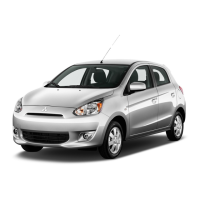Never adjust the seats to extend a luggage
compartment while the vehicle is in
motion or on a slope.
The seats could move suddenly and cause
serious injury or an accident.
After returning a seatback to its normal
position, make sure that the seatback is
firmly secured. If the seatback is not
secured, it could move and cause a serious
accident.
Do not allow anyone to ride in the luggage
compartment while the vehicle is in
motion. People who are not properly
seated and restrained can be seriously
injured or killed in an accident.
The luggage compartment in the rear of
the vehicle should never be used as a play
area by children. All children should be
properly restrained in a restraint device
that offers the maximum protection for
their size and age. Refer to “Child
restraint systems” on page 4-18.
The front passenger seat is equipped with
weight sensors. Depending on the weight
detected, the front passenger airbag is dis-
abled or enabled. When folding the rear
seats forward for increased cargo capac-
ity, the front passenger seat and seatback
must be adjusted to assure they are not
contacting the rear seat. In the event the
front seat or seatback is allowed to contact
the folded rear seat, proper operation of
the front passenger airbag system may be
affected.
In the luggage compartment, do not load the
luggage higher than the top of the seats and
make sure that the luggage is firmly secured.
Restricted rear vision or unsecured objects
entering the passenger compartment from the
luggage compartment during sudden brak-
ing can cause serious injury or an accident.
Seatbacks should always be folded and put
back into normal position by an adult. Seat
adjustments by a child could lead to an unex-
pected accident.
When adjusting the seats, be careful not to
catch your hand or leg. Personal injury could
result.

